There are lots of hidden gems in Egypt that even Egyptians do not know that they exist. Among those gems, a palace in a very quiet Upper-class Zezenia neighbor in Alexandria.
Not only that place is a hidden gem but it also hosts gems.
I paid it a visit last May while I was in Alexandria for a short visit.
That place is Princess Fatima Haider's Palace that hosts a collection of the Mohamed Ali-Royal family's Jewelry.
Officially, that palace is called the Royal Jewelry Museum.
This post I am dedicated to the Palace itself and you will know why.
The Fatima Haider Palace seems just like any 1920s Neo-classical European style Palace from outside.
It is big as we are speaking about 4185 sq.m including the surrounding garden.
The Palace was originally commissioned by socialite Zeinab Fahmy, the wife of Prince Ali Haider in 1919 but she died leaving it to her daughter Fatima Al-Zahra Haider.
Princess Fatima Haider continued supervising the design and construction of that place adding her touch to the final design adding a Western wing to the original Palace.
The construction of that palace was finished in 1923 amazingly
According to some sources that the palace was designed by Mohamed Ali-Royal Family's favorite architect Antonio Lasciac while other sources say that famous architect Ali Pasha Fahmy whom I am going to speak about later.
I do not know which information is true.
The two-floor-palace is made of two wings, an Eastern and Western wing connected by a gallery of beautiful stained glass.
The kitchen and the Servants section are in the basement.
It was the summer residence for Princess Fatima Al-Zahra Haider who married Mohamed Bek Yaken in 1930.
The couple had two boys and one girl.
After the coup of 1952, Princess Fatima Al-Zahra's properties and possession were confiscated by the State aka nationalized.
Yet, She was allowed to live in that palace.
She lived there till 1964 when She gave it up to the Egyptian government.
Some sources say that the former Princess headed to Cairo where she lived until her death in 1983. while other sources say she lived in Marseilles, France until her death.
Since 1964 till 1986, the Palace joined the rest of the Royal palaces that became presidential palaces.
In 1986, ousted President Mubarak issued a presidential decree designating the Fatima Haider's Palace into a museum in Alexandria hosting a collection of Mohamed Ali-Royal Family jewelry in Alexandria.
The Palace was renovated twice in 1986 and 1994 in a horrible way.
In late 2004, Egypt's ministry of antiquities started to renovate the palace in a proper way.
The cost of that renovation as well correcting the mistakes of previous renovations reached LE 10 Million.
The renovation finished and it was reopened once again in 2010.
But like a diamond in the rough, it has not caught enough attention.
Now, this museum contains a collection of Jewelry and other valuable possessions that once owned by the members of Mohamed Ali-Royal family that ruled Egypt from 1805 till 1952.
According to the official information, there are 11,500 pieces or artifacts owned by the former ruling royal family in the museum.
I will dedicate a separate post for the Jewelry of Mohamed Ali-Royal Family but I will just say that this collection at the museum represents a very small percentage of the true Jewelry and Jewels owned by the Egyptian Royal family.
The entrance is from the East wing that leads directly to one of the main halls where you start to see the amazing collection of Jewelry.
Since you enter that place and start moving around, you will be distracted by the ceiling as well the walls in some chambers and the stained glass balconies.
Exhibit No.1 for the ceiling.
Exhibit No. 2 for the ceiling and pay attention to the initials
The murals on the walls Little wall boiserie are also beautiful. I am trying to imagine the kind of furniture that would fit with such walls and I fail.
Exhibit No.3
Every little detail in the chambers of that palace is interesting
Exhibit No.4
The gallery between the Eastern and Western bridge is another masterpiece of art in that palace.
Exhibit No.5
The ceilings got three different main murals depicting imaginary renaissance scenes about lovers, angels, muses and arts.
Exhibit No.6
Exhibit No.7
Not all the chandelier lamps are working as usual in Egyptian museums.
Exhibit No.8
Another scene for those two beings.
On both sides of that gallery connecting the Eastern and Western wings, there are colored stained glass windows on depicting romantic scenes from European renaissance era.
Exhibit No.10 and No.11
There is also an Arabian style chamber, I think the smoking room. You can see again the initials of "FH" near the ceiling if you zoom in.
Exhibit No.11
You will find as well a Greco-roman chamber where you will find the walls oil painting showing scenes from the Greek and Roman mythology.
Exhibit No.13 and No.14
On the first floor, there is this ceramic room which could be the guests' bathroom or the kitchen but as far as I know the kitchen was in the basement as it was the custom of palaces in the old days.
Exhibit No.15
The Upper part of the ceramics in that section includes lotus flowers and wheat, strangely that mix of different styles looked good.
Exhibit No.17
The staircase leading to the second floor is so beautiful with its colored stained glass.
Exhibits No.18 and No.19
The second floor includes several chambers used to show collections of Jewelry owned by the Mohamed Ali Family too and again you have to pay attention to the ceilings.
Exhibit No.20
In the second floor, there are two private bathrooms and they are actually time capsule chambers as they are keeping their items from toilet, sink and bathtub in a perfect condition.
Here is the first private bathroom. It is not the main bathroom.
Exhibit No.21
Now, the main private bathroom of late Princess Fatima Al-Zahra Haider is another piece of art.Yes, I am using that terms more than once in this post but for a good reason.
Exhibit No.22
The bathtub unit and pay attention to the details
And here is the 1920s Shower box where you can see that even that small space got ceramic depiction of some girl taking a bath in some river or sea naked.
Exhibit No.23
Here is a full view for those ceramic depictions of fairy tales.
Exhibits No.24 and No.25
We are not finished yet from that bathroom because just like the rest of the chambers in the palace , you must look up to the ceiling.
Exhibit No.26
You can see the rest of the photos of the palace here on Flickr.
Now seeing this amazing palace of Princess Fatima Al-Zahra Haider who was not really famous in the Egyptian society like the sisters of King Farouk, I am trying to imagine the palaces of Princess Fawzia and other prominent members of the former Royal family.
I am trying to imagine the kind of furniture or carpets in that palace.
Needless to say despite I may seem to be a Royalist but I won't deny that seeing such interior of that palace only without the furniture made me understand the true problem of social justice pre-1952.
Unfortunately , the Egyptian Republic and the presidents who came after king Farouk have not truly solved it.
Again this is the palace only , you have not seen the Jewelry collection in it.
Speaking about the Royal Family, again Princess Fatima Al-Zahra Haider was the daughter of Prince Ali Haider, the great grandson of Mohamed Ali Pasha and Socialite Zeinab Fahmy.
There is no much about this man except that he loved Turkish and French poetry.
I do not know much about Fatima Haider or her mother except that they had one hell of an expensive amazing taste.
Personally, I think Fatima Haider was wealthier than many members of the Mohamed Ali-Royal Family because of her mother.
Zeinab Fahmy descends from the Pre-1952 Filthy rich Fahmy family.
Zeinab and her sisters Aziza and Aisha Fahmy were the daughters of famous Ali Pasha Fahmy, the head architect of the Royal palaces in Egypt.
Both Aziza and Aisha Fahmy got two palaces that still are standing up till now high in Cairo and Alexandria.
The Aziza Palace Fahmy in Sidi Bishr is still standing with its vast garden against the plan to turn it into a mega-7 stars ugly hotel complex.
There has been a bitter between the government represented in EGOTH and the remaining members of Fahmy family.
Located directly on the Nile bank in Zamalek island, the Aisha Fahmy palace at the end of the 26th July street is owned by the ministry of culture.
It has been renovated in the past few years. I do not know if people are allowed to visit it or not but it looks luxurious.
Maybe, if Zeinab Fahmy did not die earlier, Fatima Haider's Palace would be named publicly after her.
Now seeing the Fatima Haider Palace , I believe Aziza Fahmy palace should be turned into some sort of a Museum or a cultural center to spread awareness in the society.
I am planning inshallah to visit the Fatima Haider's Palace again in the future to film it.
Not only that place is a hidden gem but it also hosts gems.
I paid it a visit last May while I was in Alexandria for a short visit.
That place is Princess Fatima Haider's Palace that hosts a collection of the Mohamed Ali-Royal family's Jewelry.
Officially, that palace is called the Royal Jewelry Museum.
This post I am dedicated to the Palace itself and you will know why.
The Fatima Haider Palace seems just like any 1920s Neo-classical European style Palace from outside.
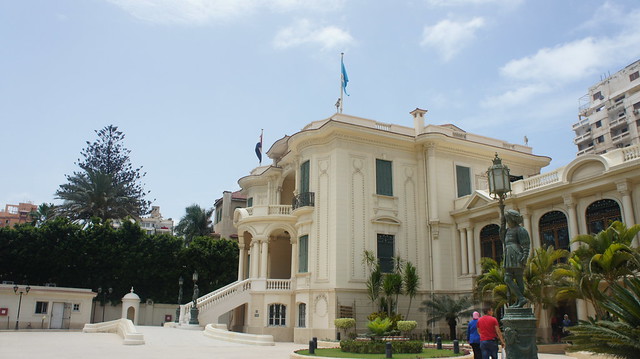 |
| The Western wing of the Palace |
The Palace was originally commissioned by socialite Zeinab Fahmy, the wife of Prince Ali Haider in 1919 but she died leaving it to her daughter Fatima Al-Zahra Haider.
Princess Fatima Haider continued supervising the design and construction of that place adding her touch to the final design adding a Western wing to the original Palace.
The construction of that palace was finished in 1923 amazingly
According to some sources that the palace was designed by Mohamed Ali-Royal Family's favorite architect Antonio Lasciac while other sources say that famous architect Ali Pasha Fahmy whom I am going to speak about later.
I do not know which information is true.
The two-floor-palace is made of two wings, an Eastern and Western wing connected by a gallery of beautiful stained glass.
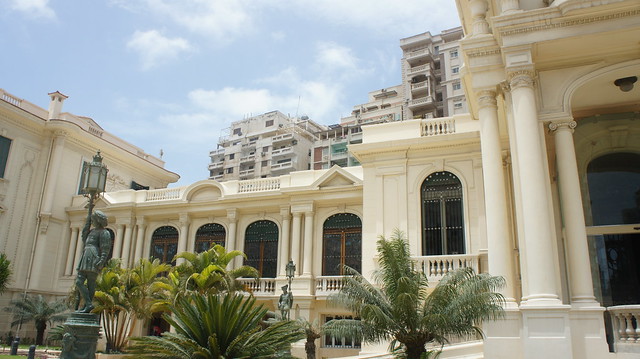 |
| The gallery or the tunnel and its stained glass windows |
It was the summer residence for Princess Fatima Al-Zahra Haider who married Mohamed Bek Yaken in 1930.
 |
| The re-inauguration plate from 2010 |
After the coup of 1952, Princess Fatima Al-Zahra's properties and possession were confiscated by the State aka nationalized.
Yet, She was allowed to live in that palace.
She lived there till 1964 when She gave it up to the Egyptian government.
Some sources say that the former Princess headed to Cairo where she lived until her death in 1983. while other sources say she lived in Marseilles, France until her death.
Since 1964 till 1986, the Palace joined the rest of the Royal palaces that became presidential palaces.
In 1986, ousted President Mubarak issued a presidential decree designating the Fatima Haider's Palace into a museum in Alexandria hosting a collection of Mohamed Ali-Royal Family jewelry in Alexandria.
The Palace was renovated twice in 1986 and 1994 in a horrible way.
In late 2004, Egypt's ministry of antiquities started to renovate the palace in a proper way.
The cost of that renovation as well correcting the mistakes of previous renovations reached LE 10 Million.
The renovation finished and it was reopened once again in 2010.
But like a diamond in the rough, it has not caught enough attention.
Now, this museum contains a collection of Jewelry and other valuable possessions that once owned by the members of Mohamed Ali-Royal family that ruled Egypt from 1805 till 1952.
According to the official information, there are 11,500 pieces or artifacts owned by the former ruling royal family in the museum.
I will dedicate a separate post for the Jewelry of Mohamed Ali-Royal Family but I will just say that this collection at the museum represents a very small percentage of the true Jewelry and Jewels owned by the Egyptian Royal family.
The entrance is from the East wing that leads directly to one of the main halls where you start to see the amazing collection of Jewelry.
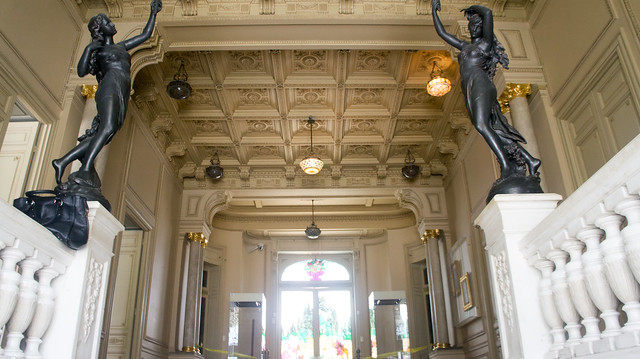 |
| Ignore that black bag on the left, this is the entrance of the museum and pay attention to the other beautiful details |
Exhibit No.1 for the ceiling.
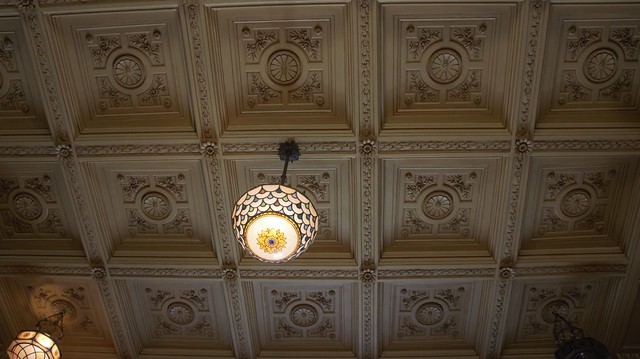 |
| This is just the start |
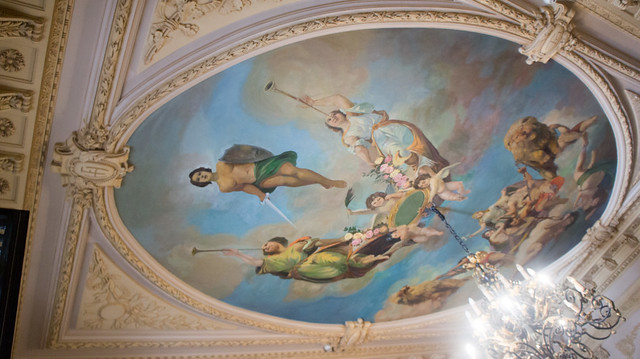 |
| European Renaissance mural in the ceiling of one of the chambers with FH initials |
Exhibit No.3
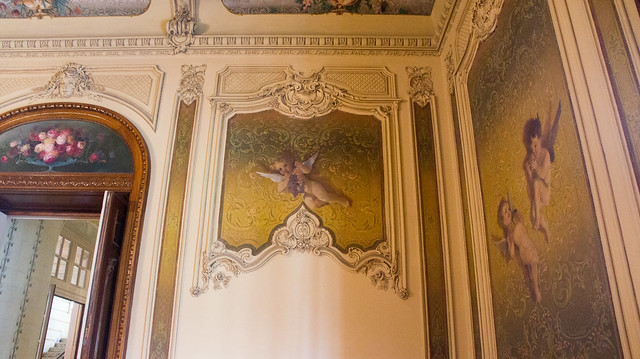 |
| Angels murals on the walls of the first wall chambers |
Exhibit No.4
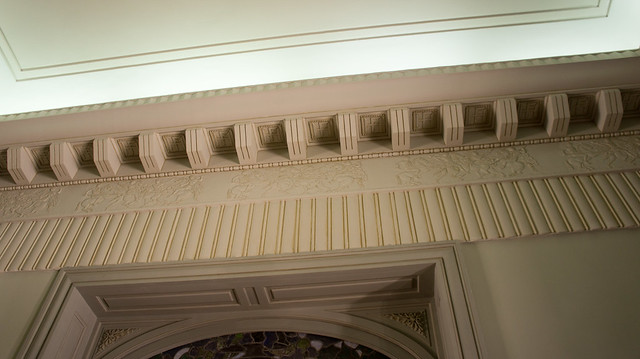 |
| The initials of FH aka Fatima Haider can be seen over the engravings near the ceiling |
Exhibit No.5
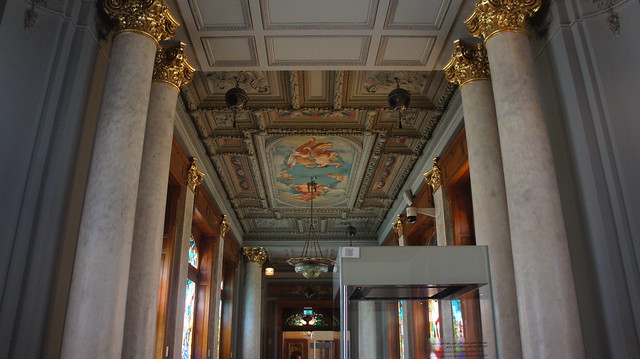 |
| The gallery between the Eastern and Western wing, an amazing piece of art |
Exhibit No.6
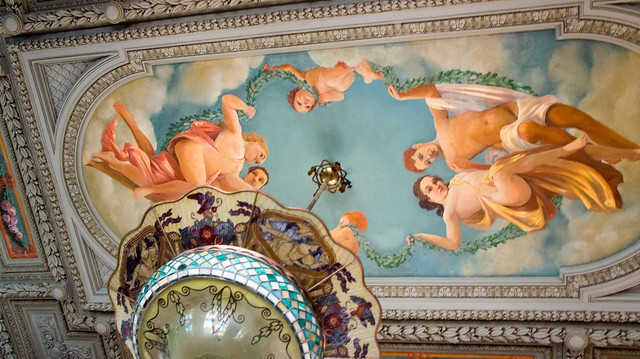 |
| The mural depicting a love scene, also pay attention to that 1920s art nouveau chandelier lamp |
Not all the chandelier lamps are working as usual in Egyptian museums.
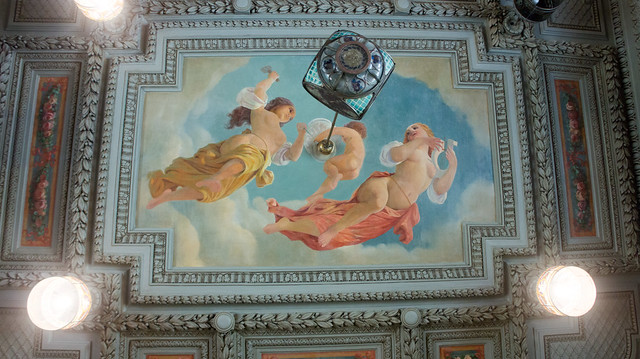 |
| Two celestial beings or whoever, one is playing the harp and the other one is engraving on something on a pot |
Another scene for those two beings.
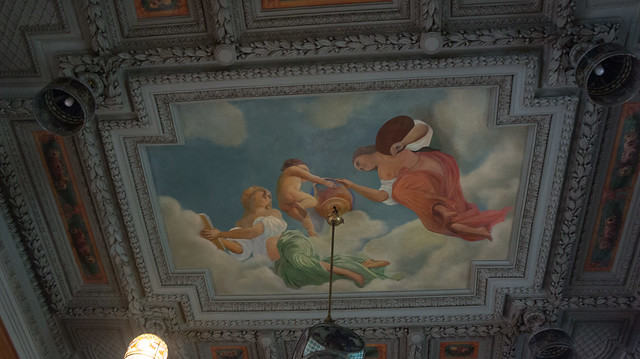 |
| Again the theme is about arts, one being is coloring a pot and the other one seems to be drawing or writing something |
Exhibit No.10 and No.11
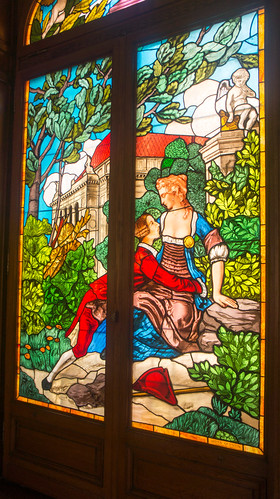 |
| A romantic scene from 17th century Europe |
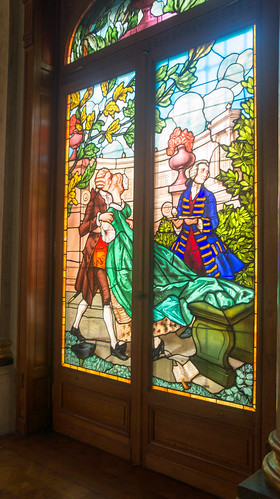 |
| A romantic scene from 17th century Europe |
Exhibit No.11
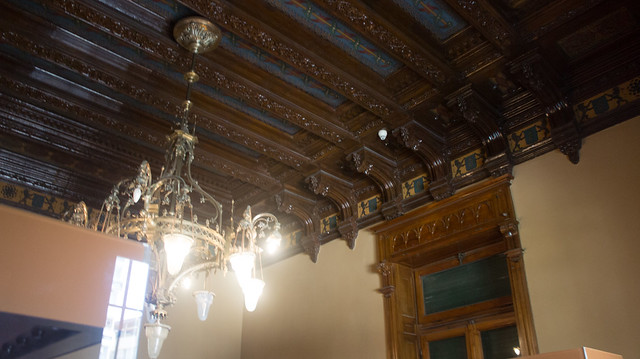 |
| The Arabian style chamber |
Exhibit No.13 and No.14
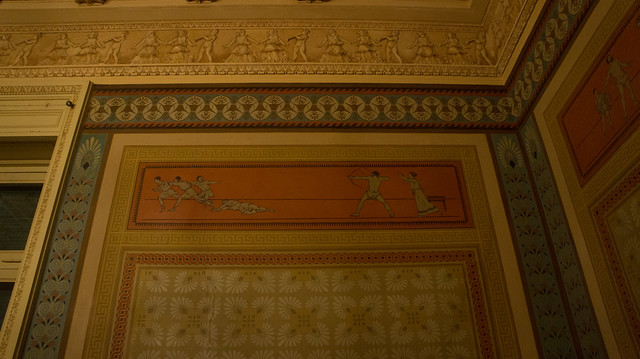 |
| A Greco-Roman scene depicted on the walls of that chamber |
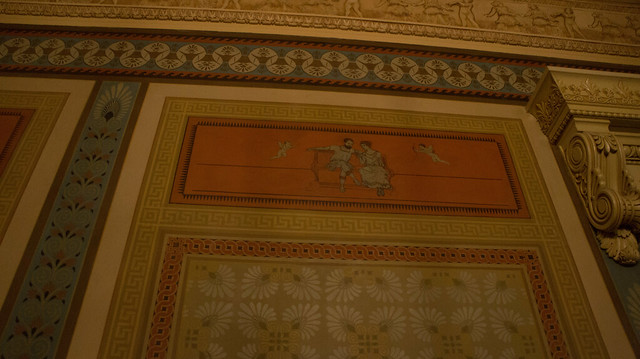 |
| Another scene, this time we see a romantic one from the Grece-Roman culture. |
Exhibit No.15
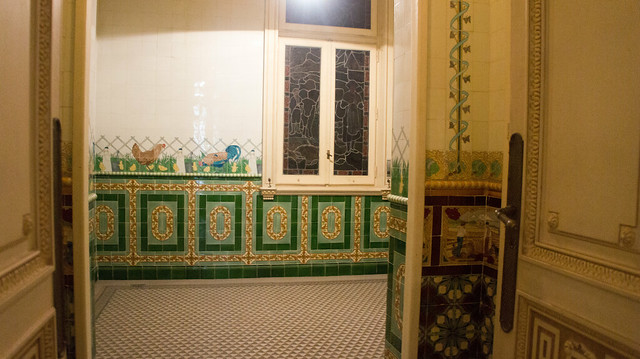 |
| The ceramic room also with stained glass and illustrated ceramics.
That section of the Palace was covered by ceramics with European farmers scenes as will Eastern style titles.
Exhibit No.16 |
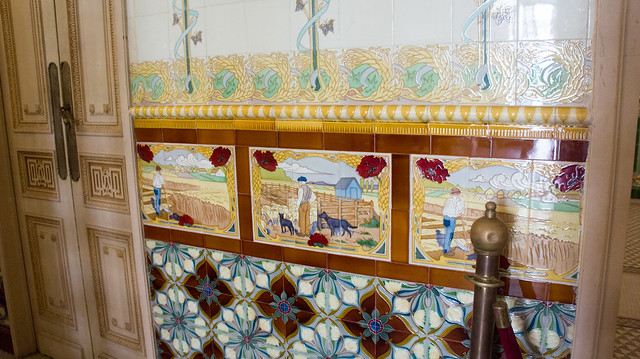 |
| A mix of several styles here I guess :) |
Exhibit No.17
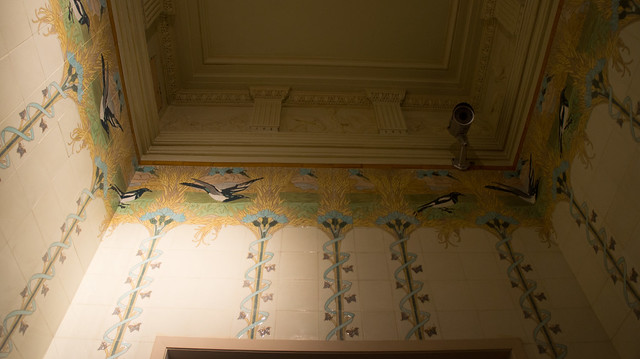 |
| The Upper section of the titles and again you can that there are birds in the above section of the wall engraved directly. |
Exhibits No.18 and No.19
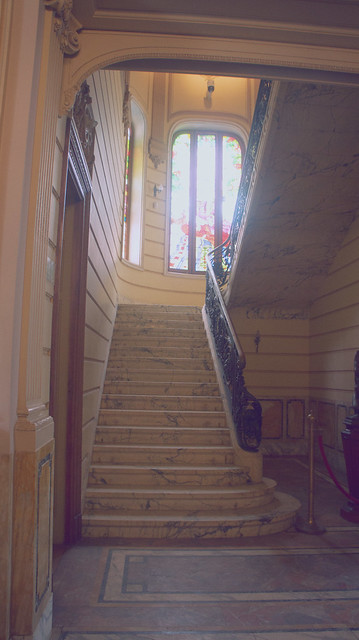 |
| The staircase and I admit I used filters here because it was so dark but the rest of the photos got no filters |
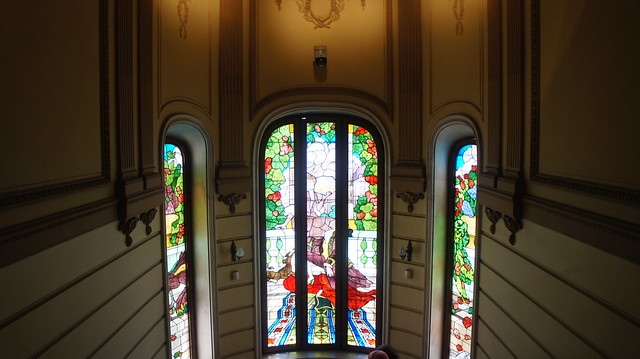 |
| The staircase to the upper second floor, the staircase itself does not show in the photo but here is the stained glass. |
Exhibit No.20
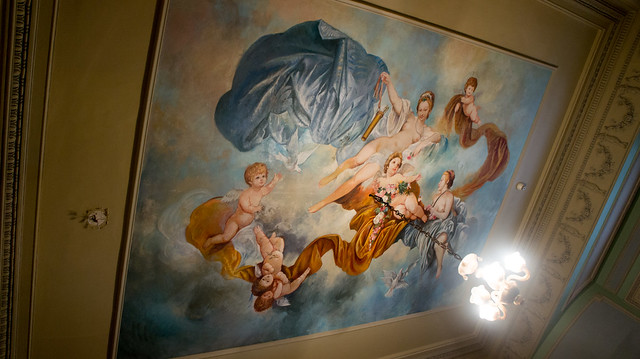 |
| More of those murals |
Here is the first private bathroom. It is not the main bathroom.
Exhibit No.21
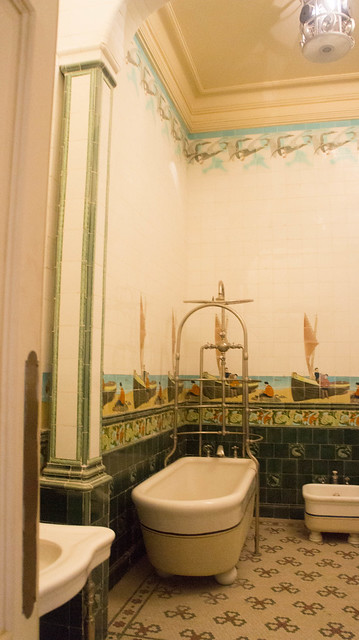 |
| This is is a luxurious bathroom in the 1920s, I think the smaller tub is a bidet |
Exhibit No.22
The bathtub unit and pay attention to the details
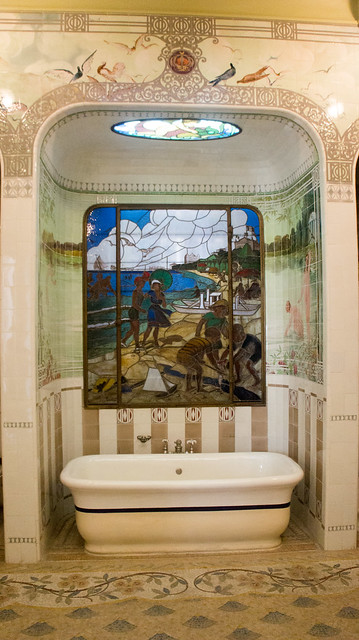 |
| The bathtub surrounded in ceramic and got two colored stained glass windows |
Exhibit No.23
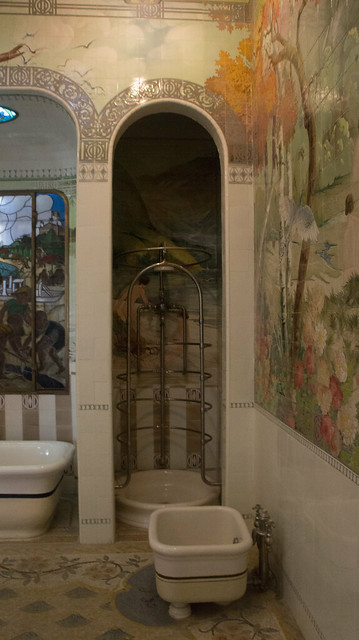 |
| The 1920s shower box and that little tub/bidet |
Exhibits No.24 and No.25
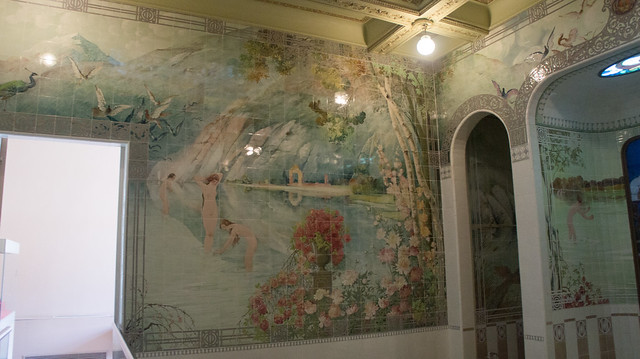 |
| On one side of the bathroom |
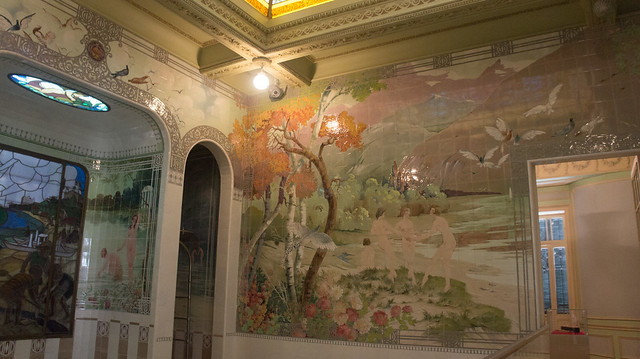 |
| On the other side of the bathroom |
Exhibit No.26
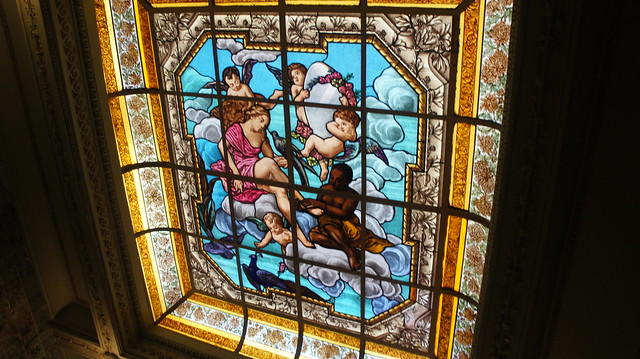 |
| This is the ceiling of the main bathroom and yes it is a bit racist |
Now seeing this amazing palace of Princess Fatima Al-Zahra Haider who was not really famous in the Egyptian society like the sisters of King Farouk, I am trying to imagine the palaces of Princess Fawzia and other prominent members of the former Royal family.
I am trying to imagine the kind of furniture or carpets in that palace.
Needless to say despite I may seem to be a Royalist but I won't deny that seeing such interior of that palace only without the furniture made me understand the true problem of social justice pre-1952.
Unfortunately , the Egyptian Republic and the presidents who came after king Farouk have not truly solved it.
Again this is the palace only , you have not seen the Jewelry collection in it.
Speaking about the Royal Family, again Princess Fatima Al-Zahra Haider was the daughter of Prince Ali Haider, the great grandson of Mohamed Ali Pasha and Socialite Zeinab Fahmy.
There is no much about this man except that he loved Turkish and French poetry.
I do not know much about Fatima Haider or her mother except that they had one hell of an expensive amazing taste.
Personally, I think Fatima Haider was wealthier than many members of the Mohamed Ali-Royal Family because of her mother.
Zeinab Fahmy descends from the Pre-1952 Filthy rich Fahmy family.
Zeinab and her sisters Aziza and Aisha Fahmy were the daughters of famous Ali Pasha Fahmy, the head architect of the Royal palaces in Egypt.
Both Aziza and Aisha Fahmy got two palaces that still are standing up till now high in Cairo and Alexandria.
The Aziza Palace Fahmy in Sidi Bishr is still standing with its vast garden against the plan to turn it into a mega-7 stars ugly hotel complex.
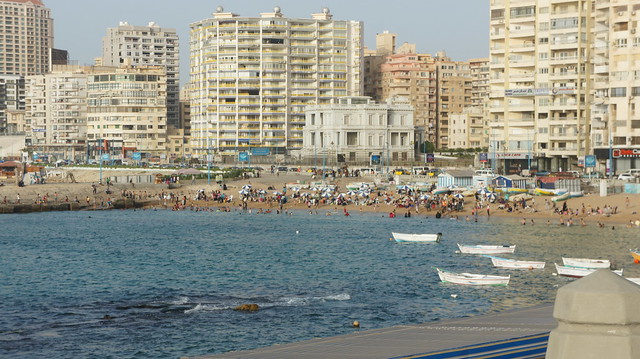 |
| Aziza Fahmy's Palace standing among ugly modern building in defiance |
Located directly on the Nile bank in Zamalek island, the Aisha Fahmy palace at the end of the 26th July street is owned by the ministry of culture.
It has been renovated in the past few years. I do not know if people are allowed to visit it or not but it looks luxurious.
Maybe, if Zeinab Fahmy did not die earlier, Fatima Haider's Palace would be named publicly after her.
Now seeing the Fatima Haider Palace , I believe Aziza Fahmy palace should be turned into some sort of a Museum or a cultural center to spread awareness in the society.
I am planning inshallah to visit the Fatima Haider's Palace again in the future to film it.

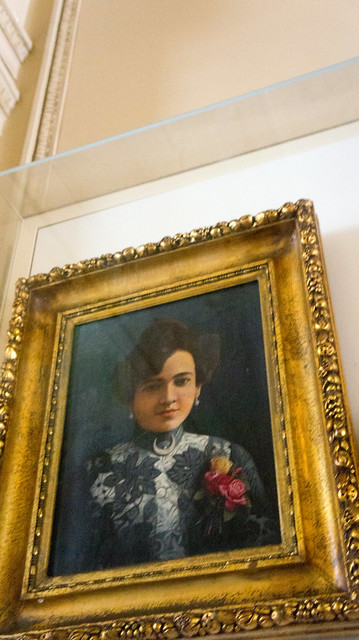
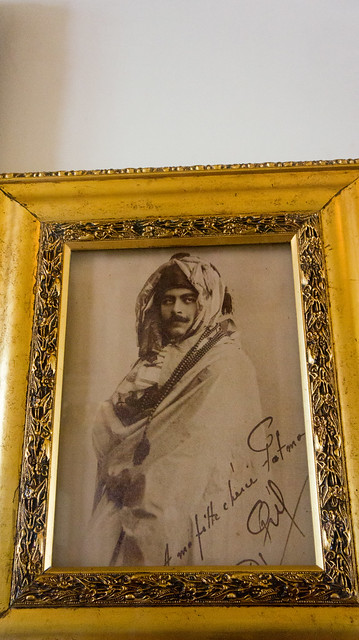
To the Hell with the Royal family and their princess.
ReplyDeleteI lived in Alexandria for 27 years
And know nothing about this palace and that princess or her mother.
Rahman Allah Gamal Abd El Nasser and
The free officers for the 1952 Revolution.
What I say now about all the poor people in Alexandria. While I see
ReplyDeleteHow their Bread were Stolen by
What they called them self:"Royal"
I think fair enough that the Mohamed Ali Royal family has not been responsible for the poverty of the Egyptians since 1952.
DeleteMay Allah swt give Egypt honest people to govern(in all levels) justly.
DeleteYes some people changed after the 1952 revolution, also the revolution enherted the consequences
Of the 1948 war.
They weren't responsible for it before 1952, either.
DeleteThey were
DeletePlease share portrait of Princess Fatima Haider. I think there was a painting displayed at the palace.
ReplyDelete